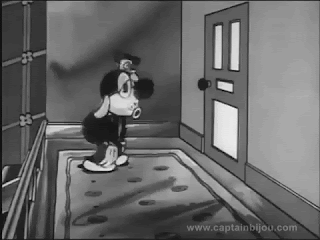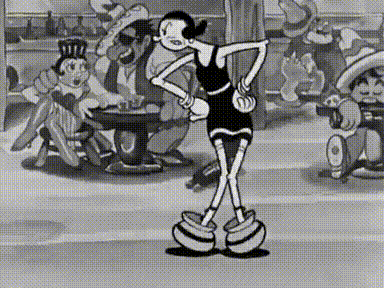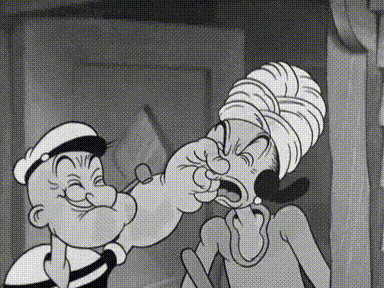What I love best about these early Fleischer cartoons is how inanimate objects are animate - in other words, animated. Things suddenly spring to life, talk, dance, make mischief. Some of them look rather grotesque. Even Betty, adorable as she is, has a massive head balancing on a sexy little body that, after 1934 and the Hayes Code, was covered up from neck to ankles. She looked like a matron in a girls' school, not a sassy little sexpot.
Showing posts with label Fleischer animation. Show all posts
Showing posts with label Fleischer animation. Show all posts
Friday, November 4, 2022
Monday, June 26, 2017
My life as a dog: the evolution of Betty Boop
I have always had mixed feelings about Betty Boop. How can I not? Her gigantic head wobbles on top of an impossibly tiny sexpot body, barely clothed: a wisp of a dress with no straps and back, a garter, fetish-calibre high heels. She speaks in a squeaky little-girl voice. And yet, there's something bold about her, something almost intrepid, as she gets herself into one pickle after another.
What shocks some people is the realization that Betty did not spring from Max Fleischer's pen fully-formed. She was a peripheral character in her first cartoon, Dizzy Dishes (1930) - well, actually it wasn't even HER in the cartoon (above). It was a grotesque, unnamed sort of dog-woman with a black nose and fleshy, pendulous ears, whose face sometimes popped out in a sort of weird canine snout. Betty wasn't even Betty then - she wasn't anything. She was named only after several false starts.
In the bizarre Barnacle Bill (later to be remade, much more effectively, in a Popeye cartoon called Beware of Barnacle Bill), her name is Nancy Lee. She still has the flappy, doggy ears and black nose, not to mention a sort of double-jointed quality. Betty/Nancy at this point is nothing more than a caricature - of what, we don't know.
I love the ability of inanimate objects to do weird things in Fleischer cartoons. What's the name for that? Does anybody know? But it's cool. Walls and sofas and things have a will of their own.
Let's face it, in these early cartoons, Betty is a real dog. The weird exaggerated glamour and sexpot persona is still miles away. Maybe it's that black nose - ewwww!
I think you see what I mean by grotesque - the rolling, popping eyes, cactus-spine lashes, spasmodic body language. The way those fleshy ears flap and dangle creeps me out. They look like ear lobes with gigantism or severe edema. In Mysterious Mose, she's a little less grotesque - it's a kind of middle stage in her evolution, but she still has a long way to go.
Note the changes, which are actually pretty radical. Her eyes have been downsized, with eye-shadowed lids. The eyebrows have been raised and made more delicate. Somewhere along the line Betty has acquired a hair stylist. I think the animators might have sat down for a conference before making this one. OK, hoop earings from now on! No more floppy flesh (though it's interesting how they felt they had to retain that familiar dangle). From then on she was Betty Boop, world's only cartoon sexpot, unchallenged until Jessica Rabbit came along some 50 years later.
And here are a few of my animations, based on the few frames available to me. These are from the infamous Dizzy Dishes, in which Betty had nowhere to go but up.
It amazes me how changing the order of the frames creates an entirely different effect: a Betty who is depressed, sorrowful, lonely, even terrified.
Monday, April 11, 2016
Saturday, September 20, 2014
Popeye the voyeur
I thought of trying an experiment with some of the early Fleischer animation: to make gifs on slow speed (with no idea of exactly how much it's being slowed down). This one came to mind, not because I particularly like it but because Olive's frenetic dancing might look sort of interesting if her stringbean arms and legs were flying around in slow-mo.
What I like about this, aside from its overwhelming sexiness, is the fact that she seems to dance in one spot while the room moves under her - no mean trick. Watch the saloon patrons in the background, and you'll see that while they're completely static, their expressions are quite amusing. Backgrounds in these cartoons were always imaginitive and done with a lot of care, though I think they were purposely minimal to avoid distracting the audience. I won't get into the 3D rotoscope thing yet - or did I already? Bish-bosh, it's just too many Popeyes, too many gifs (to paraphrase an old Hungarian proverb).
This is one of the few Popeye cartoons where he actually says "Arf, arf, arf," like he did in the original Segar comic strip. Popeye soon evolved past such things, developing his "ack-ack-ack-ack" laugh and the bizarre scat-singing version of "I'm Popeye the Sailor Man" (which I can't reproduce here - I'm working on an imitation of it for the grandkids). He also muttered to himself in perversely funny ways that were generally not scripted, followed by an exclamation of "Woaawwwwwww!"
Olive dances with great elegance in spite of, or because of, the spittoons caught on her enormous feet. I always thought Olive was perfect for Popeye - there is not one thing about her that is appealing or attractive or charming in any way - she's just plug-ugly, though something must have happened somewhere along the line to produce Swee'Pea. My favorite move here is the Windmill, also called the Egg Beater. Slowed down, you can see some of the tricks the animators used, the shadows falling quite realistically on the floor (try finding that today!), the little lines drawn to indicate a blur of speed or the impact of the spittoons on the floor.
Sadomasochism at its finest. Along with her plug-ugliness, Olive is not just plucky but brutal, obviously needing no protection from any man in spite of all her irritating mock-flirtation. Slowed down, the violence is even more horrible, but you also get a better view of those beautifully-drawn shadows, lending the cartoons an air of reality which the audience would not even consciously notice. The other thing is, and I have no idea why they did this, in the first twenty or so Popeyes, everyone constantly bounces up and down. Animation was still relatively new then, and stillness must have seemed like the equivalent of dead air on the radio. Everything must be in motion at all times. Slowed down, however, it does look a little bit like heavy breathing. Popeye the voyeur.
Popeye, with no teeth, a popped-out eye, a grossly-deformed chin and grotesque forearms, not to mention tiny pimple-like elbows and knees, went on to become one of the most beloved cartoon characters in human history, proving personality can overcome any obstacle. Or so they say. I think it was the violence.
Dear Sir or Madam, will you read my book
It took me years to write, will you take a look
Order The Glass Character from:
Barnes & Noble
Thistledown Press
Sunday, September 14, 2014
Eugene the Jeep
This is probably my favorite of my many favorite cartoons from the first Popeye series of the early 1930s. Long ago, my children got fascinated with these (they came on TV at about 5:30 in the morning, so I videotaped them and we watched them together), and at one point I sent my 8-hour collection someplace to have them transferred to DVD. I never saw them again. But a few years ago, I happened upon a cleaned-up, pristine, re-released boxed set and was in Popeye heaven. I was a bit surprised to see these in glorious black and white, as the ones we saw back in the '80s were in colour. Later I found out they had been sent to Korea to be badly colorized, probably by Ted Turner. (Why Ted Turner was forgiven for all that atrocity amazes me, but he was, and his name now proudly stands for Turner Classic Movies, a bastion of cinematic purity with no interruptions, no edits and no commercial breaks. How did he pull that one off?)
Considering what an adorable creation Eugene the Jeep is, it surprises me that Fleischer only used him in two cartoons. In this one, he rescues Swee' Pea from certain death by taking Popeye on a wild Jeep chase. The second one just doesn't have the same charm. In the kind of cruel boondoggle I came to expect as a sullen, embittered little girl, the animators decided to un-make him and start all over again, having him delivered in a mysterious box (a gift from Olive - ?) to Popeye's door.
But it doesn't really matter what Jeep does - it's all adorable. He's a sort of magic teddy-dog with the ability to dematerialize, walk through walls and foretell the future. His tail makes a sort of jingly sound, and every so often he goes, "jeep, jeep". But all this is barely touched on in these two cartoons - in fact, in the second one he hardly has any mojo left at all. .
Like all the Popeye characters, Eugene got his start in the "funny papers", in a highly eccentric 1920s comic strip called Thimble Theater. Popeye was probably the least likely of them to get his own cartoon franchise. Since the Jeep started off as a static comic strip character, the animators would have had very little idea of how he was supposed to move. I think they did a delightful job with him, with his spins and twirls.
This is a particularly neat sequence, and an example of what Fleischer and his animators did best. Labyrinthine chases that double back on themselves are a standard feature, usually involving Popeye risking life and limb. (This is one of the very few cartoons in which he does NOT eat his spinach. Even spinach is no match for the power of the Jeep.)
A superb moment!
Though Popeye doesn't eat his spinach, Eugene eats his orchids. I just had a thought as to why he only appears twice. Cute as he is, it would be hard to think up "business" for him. He has to be the centre of the action, with all that spooky magic power, so he can't just be a faithful Jeep trotting along at Popeye's heels. But what sort of action, when Popeye cartoons are usually of the knockdown-dragout variety? Where would Bluto fit in? Or Wimpy, for that matter? Most of the Thimble Theatre characters were dumped when Popeye went animated. For the most part, the whole cartoon series revolved around that eternal triangle: Popeye, Bluto and the raven-haired wench who holds them in her fatal spell.
I just remembered something about this ending, which only appears in the first few cartoons. When we were watching them on VHS tape, we only saw a tiny flash of "something" that looked like an inkwell. The people who colorized the cartoons had so adulterated the animation that this logo almost disappeared, or was reduced to a fraction of a second. So the game was to pause the tape at the exact moment when that frame or two appeared. We also acted out a dramatic version of Barnacle Bill the Sailor, but I doubt if either of them remembers it. Oh, the memories.
Subscribe to:
Comments (Atom)



































